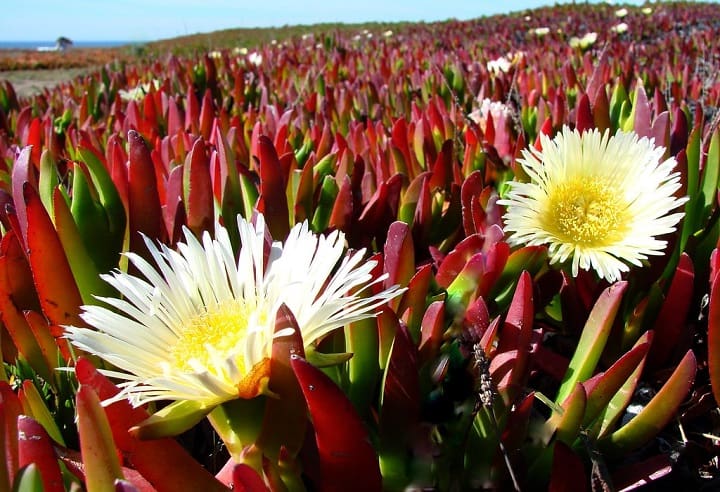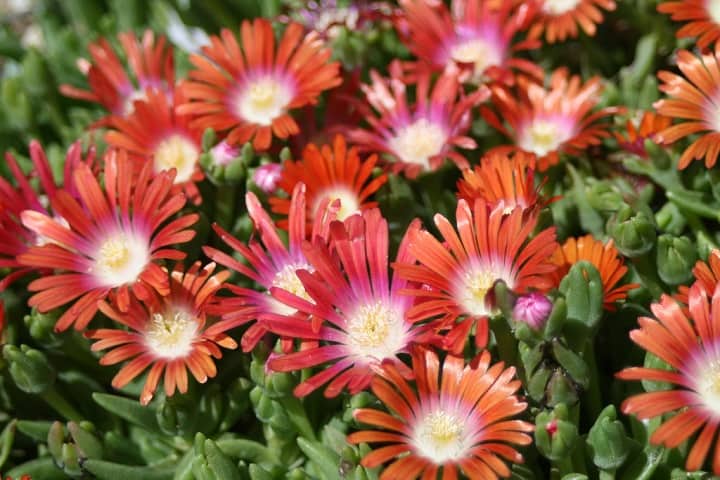Ice Plant Winter Care: Beating the Chill
Imagine a lush carpet of vibrant flowers transforming your sandy, rocky areas into a summer paradise. That’s the magic of ice plants! These low-maintenance perennials don’t ask for much, yet they deliver stunning blooms from July through September. But what happens when winter arrives? Don’t worry – ice plants are tougher than you think. Keep reading to discover how to keep them thriving all year round.

Contents
Planting Ice Plants
Spring is the perfect time to introduce ice plants to your garden. They’ll have plenty of time to settle in before winter’s chill. Choose the sunniest spot you have, with well-drained, sandy soil. This sets the stage for a long-lasting, flowering perennial.
In your prepared garden bed, dig small holes about 8-10 inches apart, making them 1.5 times the size of the plant’s rootball. Check that the soil is loose and permeable, adding sand or gravel if needed. Then, remove the plants from their pots and place them at the same depth they were previously growing. Water well on planting day and for the next few days to encourage strong roots.
Ice Plant Care in Winter
With the right conditions – full sun and sandy, well-drained soil – ice plant care is a breeze. Follow these simple steps for healthy, vibrant plants:
Location
Ice plants crave as much sun as possible to produce abundant, showy flowers. The more light they receive, the better they’ll bloom. Choose the sunniest spot in your garden or landscape.

Soil
These resilient plants thrive in poor, sandy or gritty soils with excellent drainage. Their succulent leaves allow them to store water, so fertile, moisture-retaining soils can lead to rot. For garden beds, amend heavy soils by mixing in generous amounts of coarse sand, gravel or crushed granite to improve drainage. For containers, use a cactus/succulent potting mix.
Fertilizing
Ice plants are light feeders. Too much fertilizer can cause leggy, uncontrolled growth. In early spring, top-dress the soil with a 1-inch layer of compost or apply a thin layer of horn shavings or cotton seed meal. Follow up in April and June with a balanced, water-soluble fertilizer diluted to half strength.
Watering
Established ice plants are drought-tolerant. Water deeply but infrequently, allowing the soil to fully dry between waterings during the growing season. Containers will need more frequent watering than in-ground plants. Reduce or eliminate water in winter when growth is minimal.
Pruning
No regular pruning is required for ice plants. However, to maintain neat, compact growth you can trim back scraggly stems or excessive growth as needed using clean pruners or scissors. The best time is in early spring before new growth emerges.
Winter Protection
Some ice plant varieties are frost-tender, so it’s best to grow them in pots that can be moved indoors for winter. For cold-hardy types, simply cover them with an 8-12 inch layer of leaves, straw or brushwood before the first frost. Remove this protection once temperatures are consistently above freezing to prevent rot.

Ice Plant Propagation
Ice plants are some of the easiest plants to propagate. You can expand your collection for free using these methods:
- Cuttings – In spring or summer, take 4-inch stem tip cuttings and remove the lower leaves. Allow cuttings to callus over for a few days, then plant in well-draining potting mix. Keep soil lightly moist until roots form in 4-6 weeks.
- Division – In early spring, carefully dig up mature plants and split apart the root ball into two or more sections using a sharp knife or your hands. Replant the divisions right away.
- Seed – Sow seeds indoors in late winter. The tiny seeds need barely any covering. Keep soil warm (around 70°F) and moist until germination in 2-3 weeks. Transplant seedlings outdoors after the last frost.
Nice Ice Plant Varieties
There are many beautiful ice plant varieties, originating from the sun-baked regions of South Africa. Some top choices include:
- Golden Nugget – Brilliant yellow flowers on compact 2-4 inch plants
- White Nugget – Pure white blooms all summer on 2-4 inch plants
- Purple Ice Plant – Vibrant purple, daisy-like flowers on 4-6 inch plants
- Dyer’s Ice Plant – Coppery foliage with soft red to magenta blooms on 2-3 inch plants
With their exotic flowers, drought-tolerance and easygoing nature, ice plants make outstanding additions to rock gardens, containers and sandy, sunny areas.
Frequently Asked Questions
When do ice plants bloom?
Ice plants put on their biggest floral show during the summer months of July, August and September. That’s when they soak up the most sunlight to fuel abundant blooms. But you don’t have to wait till summer to see their cheerful flowers! Some varieties like the Delosperma congestum kick off the display as early as April. And after the initial summer bloomers take a break in July, other types like the yellow Delosperma lineare or the hardy Sutherland ice plant keep the color going strong.
Are ice plants toxic?
There’s some debate over whether ice plants are toxic or not. Since there isn’t solid scientific evidence one way or the other, it’s best to exercise caution. To be on the safe side, keep ice plants out of reach from small children and pets who may be tempted to nibble on the succulent foliage or flowers. While their toxicity is unconfirmed, it’s not worth the risk when there are so many proven non-toxic plant options.
